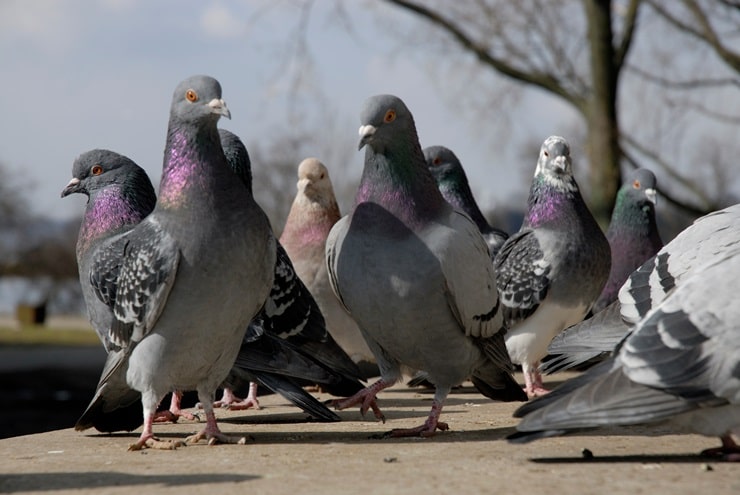A group of pigeons is most commonly referred to as a flock. But like many birds, the collective noun for pigeons depends on the context. For example, pigeon breeders often refer to groups of pigeons as “kits”. And when a group of pigeons is flying, they are sometimes called a “flight”.
Pigeons are a common bird species, and that is likely why their most popular collective noun, flock, is a common one. Additional collective nouns for pigeons that are not often used include a loft, a dropping, a plague, a passel, a band, and a school.
Baby pigeons do not have a specific collective noun. However, baby pigeons are called squabs. Once a squab hatches, it stays in the nest for around thirty days until it matures into a fledgling.
Table of Contents

Why should We Care about Pigeons?
Pigeons are usually seen as pests by city planners and city residents. However, they can serve a vital purpose to the humans and other wildlife around them.
Pigeons are a social species of bird in the Columbidae family, which contains nearly 350 species in 50 genera. Pigeon species have colonized most of the planet except the driest deserts and the coldest climates.
The most prolific and common pigeon species is the feral or rock pigeon, Columba livia, which can be found in metropolitan areas all over the world. This bird serves as an important part of the food chain for wildlife populations that cling to life amidst high rises and skyscrapers.
Pigeons can also serve as a biological indicator species in these large urban areas. One study of wild pigeons from the Netherlands found that the pigeon populations within cities can be used to assess potential human exposure to heavy metals polluting the air at different densities of traffic.
Do Pigeons Flock Together in Groups?
Pigeons flock together in groups of various sizes. Many pigeon species have flocks containing only a couple of hundred birds or less. More populous species of pigeons like rock pigeons, however, flock together in groups that can number a thousand or more birds.
According to a Chinese study, flocks of pigeons are well coordinated and regulated. Researchers have observed the movements within flocks and have determined that a joint connection exists that allows the birds to efficiently communicate at a low cost.
This interconnectedness for efficient communication is a learned behavior. When new birds, whether they are juveniles or new adults, join a flock, it takes them some time to observe and learn the flock’s behavior patterns before the new birds are completely integrated.
Why is Flocking Important for Pigeons?
The reason why pigeons flock together is for basic species survival. Pigeons serve as prey to many species including hawks, falcons, foxes, owls, and cats. However, one of the biggest predators of many pigeon species is humans.
Humans hunt many species of pigeons throughout the world such as turtledoves, mourning doves, and wood pigeons. One famous species of pigeon, the passenger pigeon, was hunted into extinction by Americans in the early 1900s.
Escaping predation is an extremely important reason for pigeons to flock. In a flock, an individual pigeon can more effectively evade a predator based on the predator avoidance of the individuals around them.
However, flocking behavior is useful to pigeons in other ways. Pigeon flocks more efficiently find food in a large group than they might as individuals. During the winter, pigeons flock together to survive the cold temperatures.
Pigeons fluff out their feathers to provide insulation and tuck their heads and feet into their feathers. By roosting in large groups, they can share their warmth and survive extremely cold temperatures.
When don’t Pigeons Flock Together?
Breeding season is the only time when pigeons do not flock together. Monogamous pairs of pigeons split off from their flock each breeding season to hatch and raise their squabs. Once the breeding season ends, the pigeon pair rejoins a flock.
Juvenile pigeons generally hang out near their nest for one or two weeks after fledging before flying off to find their own flock. Once in a new flock, the juvenile pigeons observe and learn the behavior of adults. After about a year, the juveniles become fully grown and find their own mate.
Why do Pigeons not Migrate South for Winter?
Carrier or homing pigeons are trained to navigate to their home roost from up to six hundred miles away. These birds were once used extensively to carry messages. When traveling to their home roost, they may fly solo, in pairs, or small groups.
Scientists have used homing pigeons to determine if flocks of pigeons reap any benefit when flying in clusters. Research has shown that the flight pattern of these cluster flocks, while beneficial for avoiding predation, comes at a high energy cost.
This research may help to illustrate why most pigeons do not migrate, even during the winters. Traveling even long distances may require more energy than most pigeon species are willing to expend.
The few pigeon species that do migrate usually travel in flocks of more than a hundred birds. They travel from place to place, finding food where they can, especially during times of scarcity. But, most species of pigeons are sedentary and stay close to the area where they were hatched.
